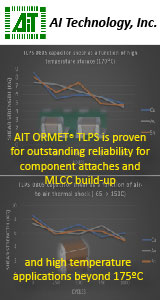| Sponsor |

|
Thermally Conductive Epoxy
Master Bond Supreme 11AOHTLP is a two component adhesive featuring thermal conductivity and electrical insulation for high performance bonding, sealing and coating.
Master Bond
|
|
| Sponsor |

|
Electrically Conductive Die Attach Epoxy
Master Bond EP17HTS-DA is a silver filled, die attach adhesive that withstands high temperatures and passes MIL-STD-883J thermal stability requirements.
Master Bond
|
|
Implementation of Assembly Processes for Low-Melting Point Solder Pastes
This paper discusses the need for low-temperature solders and process-ability of solder pastes with three novel alloys against the industry standard.
Materials Tech
DOWNLOAD
|
Authored By:
Adam Murling, Miloš Lazić, Don Wood, and Brook Sandy-Smith
Indium Corporation
Martin Anselm
Rochester Institute of Technology
Summary
In the last three to five years, there has been a resurgence of interest in the use of low-melting point alloys for SMT applications. Typically the compositions are around the eutectic bismuth-tin alloy, perhaps with additions of other elements to increase the robustness of certain alloy properties. Now, there are several new products on the market and numerous ongoing reliability projects in industry consortia.
Alloy reliability is typically the main focus of the ongoing research, but this study will investigate the “process-ability” of these new materials and considerations to implement a new low-melting point solder paste assembly process. Data presented will compare the stencil printing performance of some of these materials to leading next-generation, Pb-free, no-clean materials. There will also be a discussion of reflow approaches for the best success.
Conclusions
In conclusion, the differences between the alloys vary when considering which test you are investigating. The print quality test offers the conclusion that the bismuth alloys have better release, printability, and response-to-pause performance than the indium-containing one. While the reflow portion offers the opposite, the indium-containing alloy offers a more desirable appearing solder joint with the caveat that it was only reflowed using an optimized profile because the alloy would not reflow at the lower temperatures of the Fast profile which was adequate and ideal for the bismuth containing alloys.
Since the same flux was used for all of the solder pastes in this study, there is no comparison to legacy solder pastes. But the printing performance on challenging area ratios clearly shows that the new materials are up to the standards expected for modern solder pastes. This will be critical to the development of low melting point solder pastes for the future.
Initially Published in the SMTA Proceedings
|
Free Newsletter Subscription
Circuitnet is built for professionals who bear the responsibility of looking ahead, imagining the future, and preparing for it.
Insert Your Email Address
|
| Sponsor |

|
Our Solutions
Discover Essegi Automation's modular solutions: flexible hardware and software seamlessly integrated into SMT and THT environments.
Essegi Automation
|
|
|
